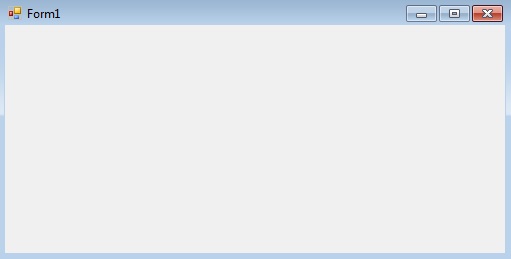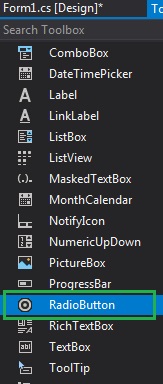En Windows Forms, el control RadioButton se usa para seleccionar una sola opción entre el grupo de opciones. Por ejemplo, seleccione su género de la lista dada, por lo que elegirá solo una opción entre tres opciones como Hombre, Mujer o Transgénero. En Windows Forms, se le permite establecer la fuente del contenido presente en el RadioButton utilizando la Propiedad de fuente del RadioButton. Puede establecer esta propiedad de dos maneras diferentes:
1. Design-Time: es la forma más fácil de configurar la fuente del RadioButton como se muestra en los siguientes pasos:
- Paso 1: cree un formulario de Windows como se muestra en la siguiente imagen:
Visual Studio -> Archivo -> Nuevo -> Proyecto -> WindowsFormApp
- Paso 2: arrastre el control RadioButton desde ToolBox y suéltelo en el formulario de Windows. Puede colocar un control RadioButton en cualquier lugar del formulario de Windows según sus necesidades.

- Paso 3: Después de arrastrar y soltar, irá a las propiedades del control RadioButton para establecer la fuente del RadioButton.

Producción:

2. Tiempo de ejecución: es un poco más complicado que el método anterior. En este método, puede configurar la fuente del control RadioButton mediante programación con la ayuda de la sintaxis dada:
public virtual System.Drawing.Font Font { get; set; }
Aquí, Font representa la fuente del contenido presente en el RadioButton. Los siguientes pasos muestran cómo configurar la fuente de RadioButton dinámicamente:
- Paso 1: crear un botón de radio utilizando el constructor RadioButton() proporcionado por la clase RadioButton.
// Creating radio button RadioButton r1 = new RadioButton();
- Paso 2: después de crear RadioButton, establezca la propiedad Fuente del RadioButton proporcionada por la clase RadioButton.
// Setting the font of the radio button r1.Font = new Font("Berlin Sans FB", 12); - Paso 3: Y por último agregue este control RadioButton al formulario usando el método Add().
// Add this radio button to the form this.Controls.Add(r1);
Ejemplo:
usingSystem;usingSystem.Collections.Generic;usingSystem.ComponentModel;usingSystem.Data;usingSystem.Drawing;usingSystem.Linq;usingSystem.Text;usingSystem.Threading.Tasks;usingSystem.Windows.Forms;namespaceWindowsFormsApp21 {publicpartialclassForm1 : Form {publicForm1(){InitializeComponent();}privatevoidForm1_Load(objectsender,EventArgs e){// Creating and setting labelLabel l =newLabel();l.AutoSize =true;l.Location =newPoint(136, 40);l.Text ="Select Your Branch";l.ForeColor = Color.DarkGreen;l.Font =newFont("Berlin Sans FB", 12);// Adding this label to the formthis.Controls.Add(l);// Creating and setting the// properties of the RadioButtonRadioButton r1 =newRadioButton();r1.AutoSize =true;r1.Text ="CSE";r1.Location =newPoint(286, 40);r1.ForeColor = Color.DarkGreen;r1.Font =newFont("Berlin Sans FB", 12);// Adding this label to the formthis.Controls.Add(r1);// Creating and setting the// properties of the RadioButtonRadioButton r2 =newRadioButton();r2.AutoSize =true;r2.Text ="ECE";r2.Location =newPoint(356, 40);r2.ForeColor = Color.DarkGreen;r2.Font =newFont("Berlin Sans FB", 12);// Adding this label to the formthis.Controls.Add(r2);}}}Producción:

Publicación traducida automáticamente
Artículo escrito por ankita_saini y traducido por Barcelona Geeks. The original can be accessed here. Licence: CCBY-SA